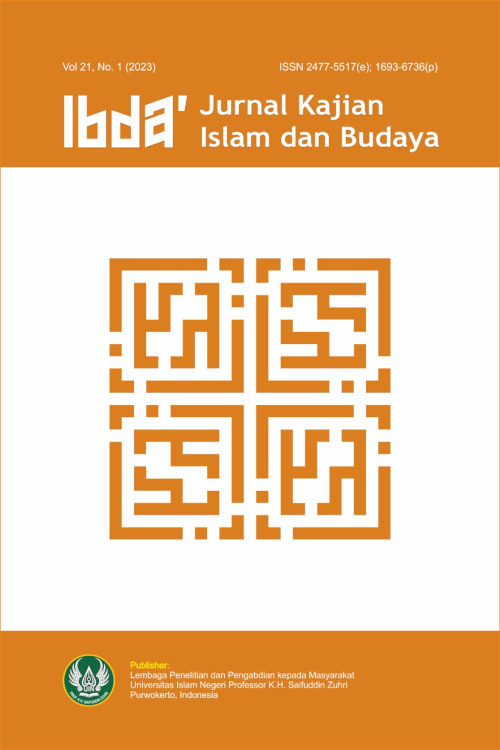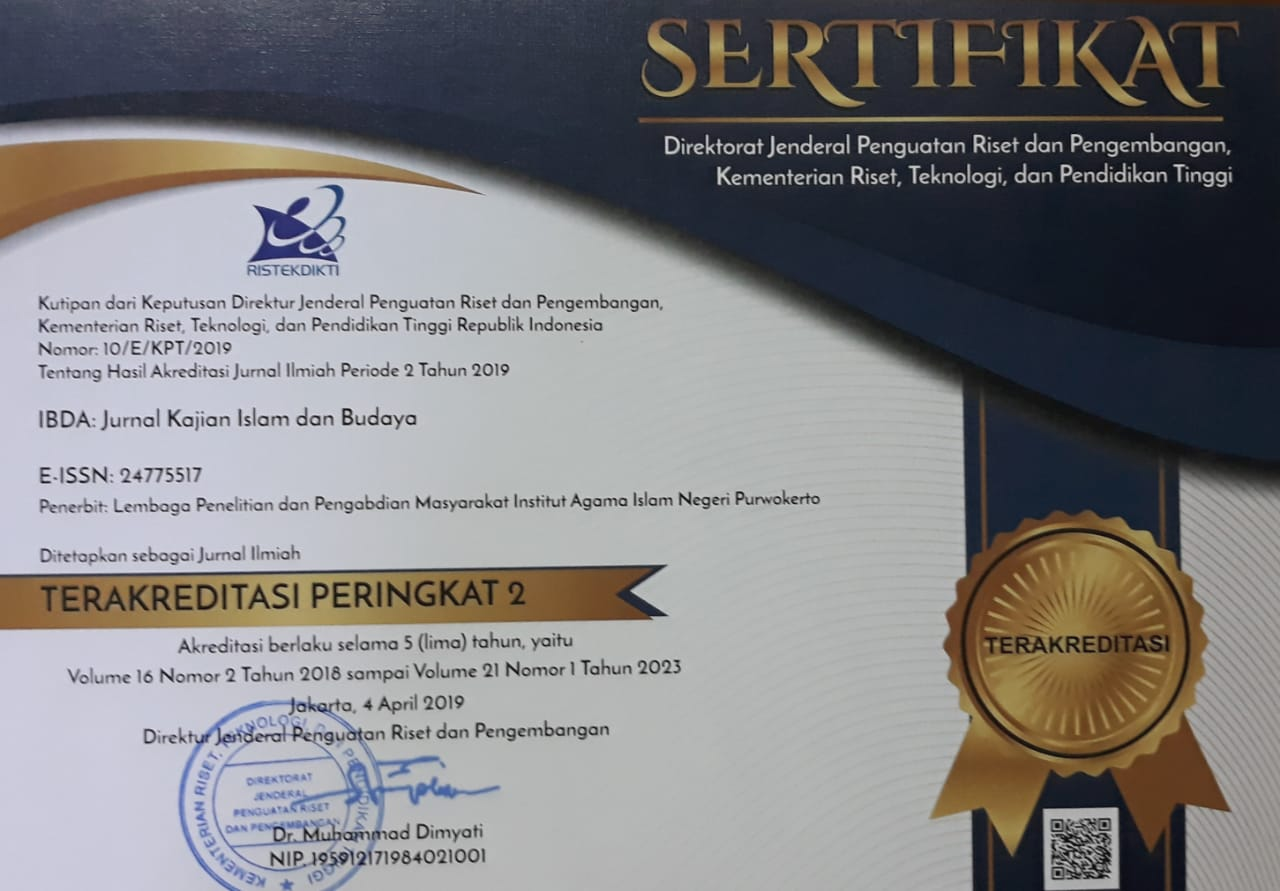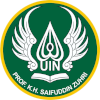The Begawan Ciptaning scene in the Gagrag Ngayogyakarta puppet show: Representation to approach the self to the essence of the God
DOI:
https://doi.org/10.24090/ibda.v21i1.6454Keywords:
Arjunawiwaha, egawan Ciptaning, moral values, puppetAbstract
Puppet stories or shows are literary works that contain didactic moral problems and aesthetic elements. Puppet shows also contain extensive guidelines (piwulang), such as religious values, philosophy, ethics, and character education for human life. Furthermore, the puppet has noble values as role models and illustrations of daily human life (pathet) and crucial to build character and national identity. This study aims to describe and elaborate on the philosophical meaning of the Purwa Puppet of Gagrag Ngayogyakarta style performance, especially the scene of Arjuna’s asceticism or Begawan Ciptaning. This research is a qualitative descriptive study. Data analysis techniques using content analysis. The results of this study indicate the role model of Arjunawiwaha’s story, especially the scene of Arjuna’s asceticism. This scene contains moral values, such as Arjuna’s firmness and persistence in trying to get closer to the essence of the world’s rulers. Another value is devotion to parents and the state, and leadership. The values found in the puppet stories are also relevant to nowadays life and are linked to Islamic thoughts.Downloads
References
Ali, M. (2019). The power of niat sebagai landasan etos kerja perspektif Hadis. Tahdis: Jurnal Kajian Ilmu al-Hadis, 9(2), 145–159. https://doi.org/10.24252/tahdis.v9i2.7536 DOI: https://doi.org/10.24252/tahdis.v9i2.7536
Anggoro, B. (2018). “Wayang dan seni pertunjukan” Kajian sejarah perkembangan seni wayang di tanah Jawa sebagai seni pertunjukan dan dakwah. JUSPI (Jurnal Sejarah Peradaban Islam), 2(2), 257–268. https://doi.org/10.30829/j.v2i2.1679 DOI: https://doi.org/10.30829/j.v2i2.1679
Ardiyanto, M., & Hidayati, F. (2015). Makna spiritualitas Begawan Ciptaning dalam lakon Arjuna Wiwaha pada pelaku seni pedalangan. Jurnal Empati, 4(4), 347–352. https://doi.org/10.14710/empati.2015.14368
Arsyad AT, M. (2012). Kajian kritis tentang akulturasi Islam dan budaya lokal. Lentera Pendidikan: Jurnal Ilmu Tarbiyah dan Keguruan, 15(2), 211–220. https://doi.org/10.24252/lp.2012v15n2a6 DOI: https://doi.org/10.24252/lp.2012v15n2a6
Astuti, H. (2021). Berbakti kepada orang tua dalam ungkapan Hadis. Jurnal Riset Agama, 1(1), 45–58. https://doi.org/10.15575/jra.v1i1.14255 DOI: https://doi.org/10.15575/jra.v1i1.14255
Barker, C. (2004). The Sage dictionary of cultural studies. SAGE Publications Inc. DOI: https://doi.org/10.4135/9781446221280
Fauziah, A. N., Rohman, A. A., Monida, W. O. G., & Hariyanti, N. (2020). Wayang ukur sebagai media representasi Indonesia. Channel: Jurnal Komunikasi, 8(1), 43–50. https://doi.org/10.12928/channel.v8i1.15096 DOI: https://doi.org/10.12928/channel.v8i1.15096
Fiddari, N. K., & Turmudi, M. (2020). Tirakat Puasa Bilaruh sebagai upaya mengembangkan ESQ (Emotional Spiritual Question) santri Pondok Pesantren Lirboyo HM Putri Al Mahrusiyah. Indonesian Journal of Humanities and Social Sciences, 1(3), 197–210. https://doi.org/10.33367/ijhass.v1i3.1519
Hall, S., Evans, J., & Nixon, S. (2013). Representation: Cultural representations and signifying practices. SAGE Publication Inc.
Huda, M. N., & Saddhono, K. (2017). Wayang purwa Gagrag Banyumasan dan peran wali. Ibda`: Jurnal Kajian Islam dan Budaya, 15(1), 135–148. https://doi.org/10.24090/ibda.v15i1.1038 DOI: https://doi.org/10.24090/ibda.v15i1.1038
Jiwandono, I. S., & Khairunisa, K. (2020). Pemanfaatan nilai-nilai filosofis Punakawan dalam upaya penguatan karakter mahasiswa. Didaktis: Jurnal Pendidikan dan Ilmu Pengetahuan, 20(1), 74–81. https://doi.org/10.30651/didaktis.v20i1.4466 DOI: https://doi.org/10.30651/didaktis.v20i1.4466
Juniarti, A. P., Saddhono, K., & Wibowo, P. A. W. (2020). Moral value analysis in Serat Kitab Kalam Qodrat for women’s moral education. El Harakah: Jurnal Budaya Islam, 22(1), 133–150. https://doi.org/10.18860/el.v22i1.8643 DOI: https://doi.org/10.18860/el.v22i1.8643
Kholil, A. (2008). Islam Jawa: Sufisme dalam tradisi dan etika Jawa. El Harakah: Jurnal Budaya Islam, 9(2), 87–99. https://doi.org/10.18860/el.v9i2.4644 DOI: https://doi.org/10.18860/el.v9i2.4644
Kurniawan, K., Putra, D. N., Zikri, A., & Mukhtar AH, N. (2020). Konsep kepemimpinan dalam Islam. Produ: Prokurasi Edukasi Jurnal Manajemen Pendidikan Islam, 2(1), 1–10. https://doi.org/10.15548/p-prokurasi.v2i1.2244 DOI: https://doi.org/10.15548/p-prokurasi.v2i1.2244
Kurwidaria, F., Rahadini, A. A., Purnama, S. L. S., & Setyawan, B. W. (2020). The cultural significance and Islamic values of Gugon Tuhon. El Harakah: Jurnal Budaya Islam, 22(2), 309–326. https://doi.org/10.18860/eh.v22i2.9389 DOI: https://doi.org/10.18860/eh.v22i2.9389
Mahfuz, A., Husti, I., & Alfiah, A. (2020). Hadis tentang niat dan korelasinya terhadap motivasi bagi peserta didik. Perada: Jurnal Studi Islam Kawasan Melayu, 3(2), 1–11. https://doi.org/10.35961/perada.v3i2.230 DOI: https://doi.org/10.35961/perada.v3i2.230
Masfiah, U., Darweni, D., Zakiyah, Z., Muzayanah, U., & Parray, T. A. (2021). Character education values in Javanese literature. El Harakah: Jurnal Budaya Islam, 23(1), 65–83. https://doi.org/10.18860/eh.v23i1.11455 DOI: https://doi.org/10.18860/eh.v23i1.11455
Mumbaasithoh, L., & Subandi, S. (2022). Psychological well-being santri yang menjalani laku prihatin di pondok pesantren salaf [Master thesis]. Universitas Gadjah Mada Yogyakarta.
Mutaqin, M. Z. (2022). Konsep sabar dalam belajar dan implikasinya terhadap pendidikan Islam. Journal of Islamic Education: The Teacher of Civilization, 3(1), 1–16. https://doi.org/10.30984/jpai.v3i1.1853 DOI: https://doi.org/10.30984/jpai.v3i1.1853
Nufus, F. P., Agustina, S. M., Lutfiah, V. L., & Yulianti, W. (2017). Konsep pendidikan birrul walidain dalam QS. Luqman (31): 14 dan QS. Al-Isra (17): 23-24. Jurnal Ilmiah Didaktika, 18(1), 16–31. https://doi.org/10.22373/jid.v18i1.3082 DOI: https://doi.org/10.22373/jid.v18i1.3082
Nurlaela, A., Ningrum, S., & Naan, N. (2020). Optimalisasi nilai-nilai fitrah dalam mendekatkan diri kepada Allah. Al Qalam: Jurnal Ilmiah Keagamaan dan Kemasyarakatan, 14(2), 163–176. https://doi.org/10.35931/aq.v14i2.387 DOI: https://doi.org/10.35931/aq.v14i2.387
Purwanto, S. (2018). Pendidikan nilai dalam pagelaran wayang kulit. Ta’allum: Jurnal Pendidikan Islam, 6(1), 1–30. https://doi.org/10.21274/taalum.2018.6.1.1-30 DOI: https://doi.org/10.21274/taalum.2018.6.1.1-30
Riyanto, B., & Mataram, S. (2018). Perkembangan wayang alternatif di bawah hegemoni wayang kulit purwa. Panggung, 28(1), 1–15. https://doi.org/10.26742/panggung.v28i1.440 DOI: https://doi.org/10.26742/panggung.v28i1.440
Rosidi, A. (2017). Niat menurut Hadis dan implikasinya terhadap proses pembelajaran. Jurnal Inspirasi, 1(1), 39–50.
Samsuri, S. (2020). Hakikat fitrah manusia dalam Islam. Al-Ishlah: Jurnal Pendidikan Islam, 18(1), 85–100. https://doi.org/10.35905/alishlah.v18i1.1278 DOI: https://doi.org/10.35905/alishlah.v18i1.1278
Santosa, I. B. (2011). Saripati ajaran hidup dahsyat dari jagad wayang. FlashBooks.
Suharto, A. W. B. (2022). Al Quran and Hadits as ideas and sources of stories in Ahmad Tohari’s novels. Ibda`: Jurnal Kajian Islam dan Budaya, 20(2), 308–321. https://doi.org/10.24090/ibda.v20i2.6945 DOI: https://doi.org/10.24090/ibda.v20i2.6945
Sukatin, S., Astuti, A., Afiyah, Z., Ningsih, S., Pranata, A., & Jannah, R. T. (2022). Kepemimpinan dalam Islam. Educational Leadership: Jurnal Manajemen Pendidikan, 2(01), 72–85. https://doi.org/10.24252/edu.v2i01.29939 DOI: https://doi.org/10.24252/edu.v2i01.29939
Sulaksono, D. (2013). Filosofi pertunjukan wayang purwa. Ibda`: Jurnal Kajian Islam Dan Budaya, 11(2), 238–246. https://doi.org/10.24090/ibda.v11i2.82 DOI: https://doi.org/10.24090/ibda.v11i2.82
Tjahyadi, S. (2009). Dekonstruksi pemahaman budaya Jawa tentang hakikat dan hubungan kawula-Gusti pada lakon wayang “Semar Kuning”. Jurnal Filsafat, 19(2), 103–125. https://doi.org/10.22146/jf.3441
Umar, M. T. (2020). Islam dalam budaya Jawa perspektif al-Qur’an. Ibda`: Jurnal Kajian Islam dan Budaya, 18(1), 68–86. https://doi.org/10.24090/ibda.v18i1.3473 DOI: https://doi.org/10.24090/ibda.v18i1.3473
Downloads
Published
How to Cite
Issue
Section
License
Copyright (c) 2023 Djoko Sulaksono, Tya Resta Fitriana, Prima Veronika

This work is licensed under a Creative Commons Attribution-ShareAlike 4.0 International License.
Authors who publish with this journal agree to the following terms:
- Authors retain copyright and grant the journal right of first publication with the work simultaneously licensed under a Creative Commons Attribution-ShareAlike License a that allows others to share the work with an acknowledgement of the work's authorship and initial publication in this journal.
- Authors are able to enter into separate, additional contractual arrangements for the non-exclusive distribution of the journal's published version of the work (e.g., post it to an institutional repository or publish it in a book), with an acknowledgment of its initial publication in this journal.
- Authors are permitted and encouraged to post their work online (e.g., in institutional repositories or on their website) before and during the submission process, as it can lead to productive exchanges, as well as earlier and greater citation of published work (See The Effect of Open Access).















